What are the ways to cover grapes for the winter in the middle zone?
Grapes in Russia are grown not only on the Black Sea coast, but also in the middle zone: Moscow, Smolensk, Ryazan, Nizhny Novgorod and other regions. Frost-resistant and winter-hardy varieties are suitable for these regions with a temperate continental climate, but they should also be covered for the winter. Read on to learn about the timing of covering grapes for the winter in the middle zone, its technology and types of covering material.
When and what kind of shelter is needed
Central Russia is characterized by warm and humid summers, but winter weather can be very changeable. Frosts below -20…-30°C are followed by periods of thaw with blowing cold winds. Only a reliable shelter can protect against such disasters.
There are several reasons for a gardener from the middle zone to cover grapes:
- protect from the first frosts if snow cover has not yet formed;
- help the plant survive temperature changes;
- protect from severe frosts, leading to cracking of the bark, freezing of the root system and buds;
- prevent grapes from dampening off during snow melting and the buds awakening too early.
The main task of the shelter is to ensure a stable temperature regime.
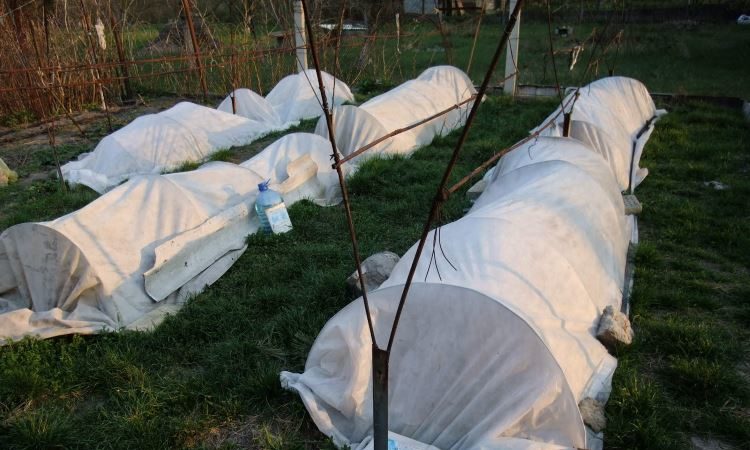
Features of grapes
The decision on the need for shelter and the choice of material depend on the variety and condition of the grapes:
- Varieties with weak frost resistance will not tolerate even -10...-12°C, so it is necessary to organize reliable frost protection for them.
- Young plants with insufficiently thick bark, as well as bushes from which a bountiful harvest has been harvested, need complete shelter. They have given up most of the nutrients and are therefore vulnerable to external factors.
- The most careful care is required for grapes weakened by pests and diseases, since at low temperatures it is difficult for such bushes to remain viable.
Degree of protection
When determining the degree of protection, the following factors are taken into account:
- weather conditions of the region, presence of stable snow cover;
- the terrain where the garden plot is located (highland or lowland);
- protection of grape plantings from winds.
In most cases, winter shelter should:
- ensure a constant temperature, that is, prevent hypothermia and too high temperatures;
- do not interfere with air exchange;
- create an optimal level of humidity.
Shelter dates
In the middle zone, grapes are covered in mid-November. However, a gardener can determine the optimal time on his own, guided by the following signs:
- ripening of the wood of the vine - the bark becomes brown;
- complete loss of leaves;
- onset of persistent cold weather down to -5°C.
An important condition for successful wintering of a plant is the construction of a shelter in dry weather with slightly frozen soil. This will help avoid overheating of the lashes and subsequent cracking of the bark.
Reference. It is advisable to pre-harden adult healthy bushes - keep the vine from several days to a month in light frosts (up to -5°C). This promotes the outflow of nutrients from above-ground organs to the roots of the plant.
How to prepare grapes for shelter
At the end of August, the grapes are minted - they pinch off the tops of shoots that have outgrown the trellis to help the remaining vine become woody more quickly. Mature wood is more viable than young green wood.
Immediately before wintering the vines:
- removed from the trellis;
- carry out pruning;
- water abundantly;
- treated against diseases and pests;
- hardened during the first light frosts.
Trimming
Trim the vine to make it easier to cover. In addition, immature shoots are vulnerable to rot and mold, and under favorable conditions the disease can spread to the entire bush.
Pruning is carried out after leaf fall - approximately in the last ten days of September. To do this, choose a dry, sunny day. The air temperature should not be below 0°C. The fruit-bearing part and the unripe growth of the fruit unit are cut off. The replacement knot is shortened, leaving up to eight buds on the upper shoot and 2-3 eyes on the lower shoot (this is the future replacement knot).
From the cut out parts you can choose cuttings for reproduction.
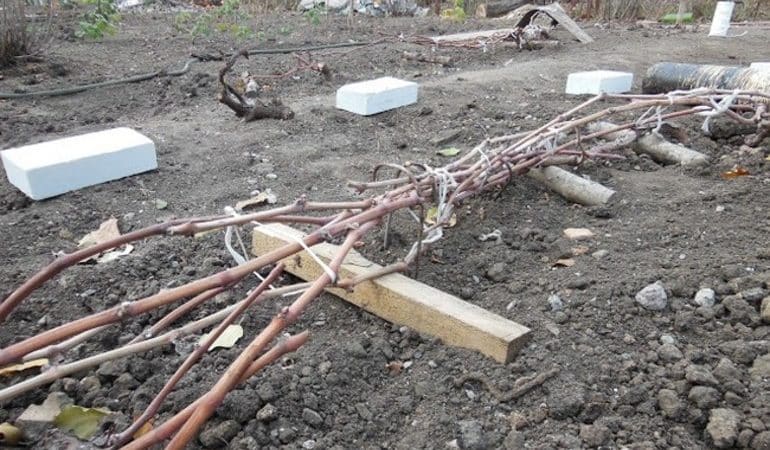
Watering
Autumn moisture-recharging watering two weeks before sheltering helps plants better withstand the winter. First, dry soil cools faster than wet soil. Secondly, at low temperatures, tissues that are not saturated with water can dry out and die.
The rate of irrigation depends on the type of soil, the proximity of groundwater, the presence of heavy rains and other conditions. Thus, a grape bush grown on loam requires 10-15 liters of water, and dry sand and sandy loam - 20-25 liters.
Reference. Before watering, fertilize so that the plant better absorbs nutrients.
Top dressing
Autumn feeding strengthens the immune system of grapes. To do this, it needs zinc, phosphorus, magnesium and potassium.Nitrogen-containing fertilizers should be abandoned during this period.
Reference. Nitrogen is excluded from fertilizing by mid-summer, since this substance excessively stimulates the growth of green mass, which prevents good fruiting of the vine and reduces the frost resistance of the plant.
Organic and mineral compounds are added to the soil depending on the quality of the soil. Fertile lands can be fertilized once every 2-3 years; sandy loam requires annual fertilizing.
Among the most popular organic nitrogen-free fertilizers are ash, peat and compost:
- water infusion of ash (in the proportion of 300 g of substance per 10 liters of liquid) is poured over grapes at the rate of 5 liters per 1 bush;
- a mixture of rotted compost and peat is laid out under the bush in a layer of 5 cm.
Among mineral compounds and complex fertilizers, preference is given to phosphorus, potassium, Nitroammofoska, etc. For example, 1 tbsp. l. potassium sulfate and 1.5 tbsp. l. double superphosphate is diluted in 10 liters of water and poured under each grape bush.
Important! To ensure adequate nutrition for the root system, fertilizers are applied not under the trunk, but in special grooves. They are dug around the bush at a distance of 50 cm from the base of the vine. Depth – 35-40 cm.
Treatment against diseases and pests
A humid and warm microclimate inside a winter shelter is fertile ground for fungal and bacterial diseases. To avoid introducing pathogens, all vines are carefully inspected for damage, and infected bushes are isolated as much as possible. But even apparently healthy grapes need preventive treatment.
Grapes are most susceptible to fungal diseases such as oidium, gray and white rot, mildew, chlorosis, and anthracnose.To combat them, folk recipes are used (solutions of salt and soda, copper or iron sulfate, colloidal sulfur, potassium permanganate), as well as special means (Bordeaux mixture, Polycarbacin, Euparen, Nitrafen, Ridomil). The preparations are diluted in water at a temperature of about 40°C in the proportions recommended by the instructions, and the resulting liquid is sprayed on the vines and the soil around them.
Malicious pests of grape plantings - thrips, spider mites, grape budworms and leafhoppers - hibernate well under plant debris and in the top layer of soil. Therefore, it is important to dig up the soil between the rows, remove fallen leaves and weed out weeds. The leaf roller can also settle in bark cracks and trunks, which means you will need insecticides based on:
- malathion (“Fufanon”, “Iskra”, Aliot”);
- cypermethrin (“Shar Pei”, “Intra-vir”, “Caesar”);
- lambda-cyhalothrin (“Karate Zeon”);
- fenoxycarb (Insegar, Lufox).
How to cover grapes for the winter in central Russia
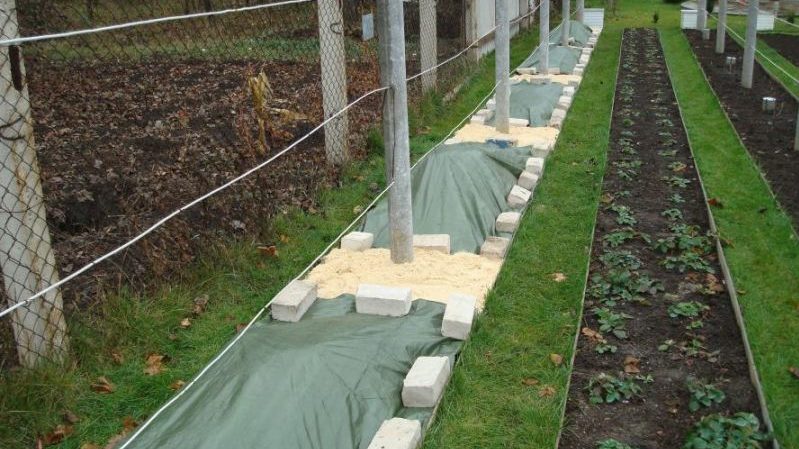
Depending depending on the chosen method of shelter use various materials and build appropriate structures.
Types of shelter
There are hilling, incomplete and complete covering of grapes:
- In the first case insulate only the root zone: an earthen mound 10-25 cm high is poured around each bush. The soil is taken from the inter-rows or from neighboring beds located no closer than 1.5-2 m from the grape plantings, so as not to expose the root system of the plant. The diameter of the mound depends on the age of the grapes - the older it is, the larger the area the roots occupy. The earth is moistened and compacted.
- Incomplete cover means insulation not only roots, but also parts of the plant located close to the ground: sleeves, bases of fruitful shoots and trunks. With this method, the roots are hilled up, and the above-ground parts are wrapped in non-woven material 4 cm or more thick.
- When completely covered, after pruning, the vine is removed from the trellis and the remaining vines are tied together with a rope. Bundles of rods are laid along the row, bent to the ground and secured with arched brackets. It is important to limit the contact of the vine with the soil, as this can lead to mold and freezing of the stems: wrap the vines with waterproof material or lay them on a substrate. For insulation, mulch, spunbond, agrospan, film, slate, etc. are used.
Shelter is also divided into wet and dry.
Wet and dry
The cover is called wet when it does not prevent water from reaching the bushes, and the mulch is not insulated from the vines. Typically, this method uses natural materials: snow and earth embankments, spruce branches, straw, sawdust, etc. Wet shelter is effective only in stable weather without thaws or snow melting.
With the dry method, the vines are isolated from mulch. To do this, different layers of covering material are used: the first is breathable and water-permeable, the second is moisture-resistant. This option is labor-intensive, but more reliable: a stable temperature regime is maintained, so the buds do not freeze or rot. With such shelter, the bushes are not afraid of thaws.
To organize a dry shelter:
- A support 30-40 cm high is installed above the lashes laid on the ground - metal arches, lattice structures made of wood, etc.
- Non-woven material (agrospan, spunbond), straw or reed mats are placed on the support.
- Cover the top with plastic film, slate, roofing felt, fiberglass.
- Vents are left for ventilation. They can be covered with a bunch of straw or a cut plastic bottle (narrow neck facing out).
- The top covering material is secured - pressed down with stones so that it does not blow away by the wind.
The design for a dry shelter can serve the owner for more than one year.
Features of sheltering young grapes
Young bushes, and even more so seedlings, need reliable shelter more than mature ones. The main danger for them is icing, so preference is given to the dry method.
If the bush is not tall, you can not lay it on the ground, but build a cone around it from wire, metal mesh or wooden pegs. The structure is filled with mulch and covered with spunbond, film or foil insulation on top. If the material does not allow air to pass through, 1-2 ventilation holes are made in it.
Disinfection of covering material
The materials must be dry and clean, so they are dried in the sun in advance. If more thorough disinfection is required process fungicides and insecticides.
To repel mice and other rodents, substances with a pungent odor (machine oil, carbide), as well as preparations containing brodifacoum (Krysin, Brodifan, Varan) or dust (Rotendant, Raninbrom) are used.
Mulch from plant materials is carefully inspected and used only without signs of rot. The foliage of fruit trees and plants with seed pods are not suitable for mulch.
Reference. Natural insecticides include tansy, calendula, wormwood and marigold. They repel insect pests, so it is advisable to add them to the shelter.
Covering materials
For shelter for the winter, different materials are used - from natural resources in the form of snow, soil and plant mulch to expensive synthetic materials. The choice depends on the objectives pursued and the capabilities of the gardener.
Hilling up with soil and snow
The roots are covered with a layer of earth of 20-30 cm, and the tied vines are laid on a waterproof shelter and covered with snow on top. The thickness of the snow cover is at least 60 cm.
This shelter is suitable for winter-hardy varieties that tolerate temperature changes and variable humidity. Its disadvantages are obvious:
- Neither snow nor soil will save you from severe frosts (the limit of their capabilities is -15°C);
- snow may fall too late and melt in the middle of winter;
- in open areas, snow and poorly compacted soil can be blown away by the winds, so they must be secured with spruce branches, brushwood or wooden slats;
- a crust of ice may form, due to which the grapes are deprived of air access and rot.
Mulch
Various materials of natural origin are used as mulch: leaves, sawdust, spruce branches, straw, etc.
Its advantages:
- environmental friendliness, absence of harmful components;
- creating an air cushion that retains heat but does not interfere with ventilation;
- additional protection against weeds;
- in the case of using spruce branches, it repels rodents.
However, mulch also has disadvantages:
- spruce branches, sawdust and peat increase the acidity of the soil;
- foliage, straw and sawdust cake and rot during the thaw, becoming moldy;
- a dense layer of straw or sawdust in the spring does not allow sunlight to pass through, so the thawing of the soil under them is delayed;
- straw shelter attracts mice;
- Low-quality mulch can introduce diseases, pests and weed seeds.
To avoid this, follow the rules:
- Materials must be dry.
- Leaves and stems are collected only from apparently healthy plants.
- It is recommended to protect mulch from moisture.
- In order not to interfere with air permeability, you should combine materials and techniques: build a metal or wooden frame around the bushes, fill it with mulch, and cover it on top with denser material with air vents.
Instead of loose straw, you can use straw mats or sheaves, laying them in a house. From such a surface, rain and melt water will roll off and will not get inside the shelter.
Slate or plywood
If your dacha is undergoing renovations, you can use leftover building materials, but there is no need to purchase them specifically - there are more reliable ways to cover grapes.
Slate is durable, it retains heat well and does not allow excess moisture to pass through. It can be used to protect grapes in trenches: wrap the vines in burlap, pin them to the ground, cover them with slate and cover them with earth and snow.
Plywood sheets are usually installed over the vines in the form of a gable roof, and the joints and ends are covered with roofing felt. Mulch from leaves is placed inside the structure. In spring, an improvised “house” is easy to ventilate - in good weather, it is enough to lift one end of the roofing material.
Film
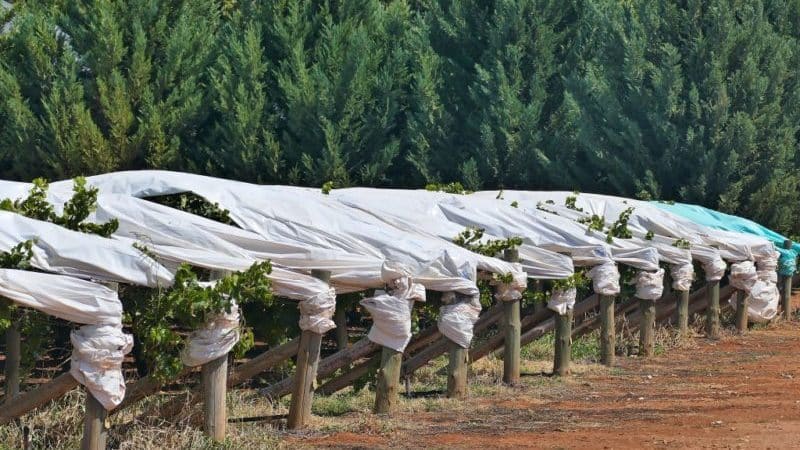
The film is used primarily to protect grape vines from excess moisture. It also prevents fertilizer from leaching from the soil and inhibits the growth of weeds.
Polyethylene film retains heat well and does not allow air to pass through. Hence its main drawback is the danger of overheating of plants.Therefore, the film is used mainly in late autumn as protection from rain, and in the spring when good weather sets in remove.
Reference. In case of excessively active sun, light-stabilizing polyethylene can be used. It will create a milder microclimate and prevent the kidneys from waking up ahead of time.
Trellis
When it is impossible to remove the vines from the trellis, make a vertical shelter:
- The lashes are moved to the center and tied compactly.
- The resulting sheaves are wrapped in several layers of insulation: straw, spunbond, spruce branches.
- For reliability, the structure is fixed using roofing felt, agrospan or weighted film (stones, bricks, boards).
Trench
For this method, grapes are initially planted in trenches 40-60 cm deep. After harvesting and preparatory activities, dry mulch is laid at the bottom of the trench, and vines tied into bunches are placed on top of it. The lashes are covered with spunbond, boards, slate or film. Snow completes the structure - the higher the snowdrifts, the more reliable the shelter.
The procedure must be carried out in dry weather. If severe frosts are expected, the trench is made deeper and wider, and the number of layers of insulation is greater. For example, additionally lay out straw, sawdust or dry leaves. To better protect the roots, covering material is also laid between the rows.
Reference. The method is applicable even for regions with a harsh climate - the Urals and Siberia.
Other materials
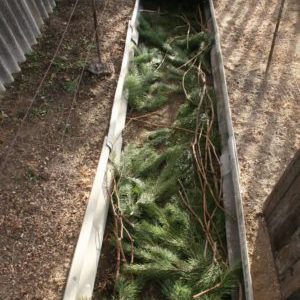
Other materials are also used to cover grapes for the winter:
- Burlap made from natural or synthetic fabrics. But the former can absorb moisture and form an icy shell when temperature changes, while synthetic ones do not allow air to pass through well and contribute to the formation of rot and mold.
- Ruberoid is a durable and flexible material, but it prevents air exchange and requires regular ventilation.
- Polycarbonate film is durable and lightweight, retains heat well, and protects from rain and wind. The main disadvantage is the high cost.
- High-density agrofibre maintains constant soil moisture, does not form condensation and does not rot, but protects only from mild frosts.
Which grapes are not covered for the winter?
Frost-resistant varieties (Vostorg, Krasa Severa, Nadezhda Azos, Dekabrsky, Kasparovsky) tolerate temperatures down to -20°C well. Under high snow cover they are able to overwinter without shelter.
Winter-hardy hybrids can withstand the changeable weather of the middle zone: Reline pink seedlis, Taiga emerald, Triumph, Siberian cherry, Amur liana.
Reference. Hybrid Valiant is the absolute champion in frost resistance. Its vine remains viable even at -47°C.
However, it is worth considering that for these varieties, thaws are more dangerous than extremely low temperatures. If a plant begins the growing season ahead of time, it loses varietal resistance to cold.
Common Mistakes
Beginning gardeners often make mistakes in organizing winter shelter for grapes. Some of them:
- They cover it too late, and the fruit buds freeze. Warm the grapes as soon as the thermometer drops to -5°C.
- They are in a hurry with the shelter, and the grapes do not have time to harden. Leave the vines bare at the first frost to prepare the wood for winter.
- They act on the principle “the more, the better”, unnecessarily wrapping the vine. To prevent grapes from budding in artificially created conditions, provide them with a period of rest - avoid excess heat and moisture.
- There is no ventilation.To avoid damping out, during prolonged thaws, lift the film from the shelter, or better yet, take care of the air in advance.
- The vine is left insulated for too long. Immediately after the snow melts, begin spring hardening of the grapes - remove the cover for several hours, gradually increasing this interval.
Conclusion
In winter, grapes suffer not only from frost, but also from changeable weather, high humidity and strong winds. An early thaw and too warm a shelter can lead to premature bud break; high humidity can lead to the formation of mold and rot. The main task facing the gardener is to provide the plantings with constant comfortable conditions so that the vine and root system can rest and gain strength for the next season.